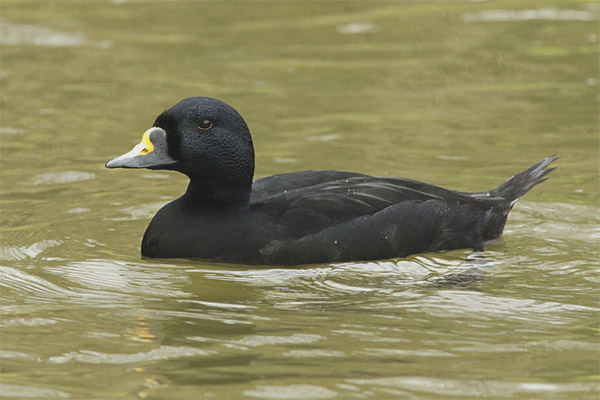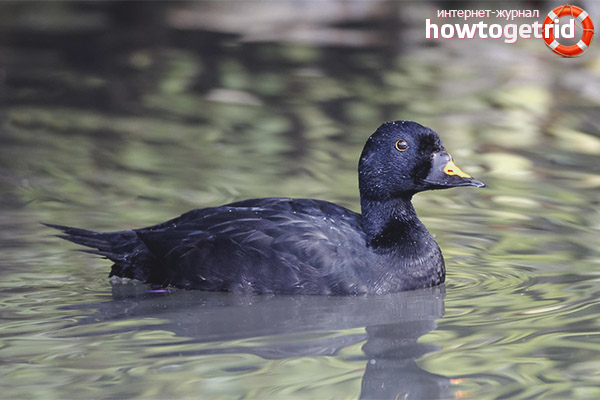The content of the article
All waterfowl deserve special attention. Nowadays, diving birds belonging to the duck family are especially popular. Consider the singu, which is otherwise called the black turpan due to specific external data. Individuals of this group live in different parts of the world, but most of them are concentrated in European countries. We will not run ahead and lay out all the cards so that below you can get acquainted with the detailed description of the representatives of the family.
Description
- Discussed diving ducks are ranked as a squad of geese. By synga is meant a bird, medium in terms of dimensional features. In size it reaches 55 cm. As for body weight, it is about 1.5 kg. The wingspan of individuals of this breed group reaches 94 cm.
- It was already mentioned earlier that the birds are called black turpans. When the mating season begins, the male gender acquires black plumage, and on the wings there are light edging.The head is brownish in color with gray splashes, the lower part is whitish with gray.
- The bill is flat, extended in the main part, there is a characteristic growth. Painted in most cases black, there is a spot of yellow. The area above the beak is yellow, but not completely. The beak has an interesting dark edging.
- A male not in the mating season is not as bright as when he starts caring for a female. In summer its plumage is brown in shade, and the bright spot on its beak dims and hardly stands out.
- As for the female, she is brown, but dark. At the same time, the pattern is scaly and light. On the head there is a circle of dark tone. The cheeks, the lower part of the body, and the neck in the area of the goiter are bright. The sections under the wings are the darkest of the rest of the plumage.
- In individuals of two sexes, paws of the same shade, that is, a dirty brownish-red tone. The tail has long, wedge-shaped feathers, which are distinguished by their rigidity. When a bird swims on the water surface, it straightens its tail and proudly lengthens the neck.
- To reveal that this representative of the family is in front of you, and not its related species, it is enough to look at the wings.They lack bands that are called a mirror.
- Chicks are covered with downy plumage, brownish or gray in color. The babies have areas of light tone, these are the cheeks, the lower section of the brisket, the neck.
Spread
Birds of the family under discussion are found in the western part of Europe, in the vast expanses of our homeland. Since birds are migratory, they do not stay long.
Winter go to the expanses of the Mediterranean Sea. There are individuals on the coasts of Italy, France and Spain. They also live in Morocco and the Atlantic. In the winter, these birds can be found in the North and Baltic Sea. If weather conditions are adverse, birds can be found in Korea, China and Japan.
As for habitat, individuals prefer the tundra, forest belt and steppe terrain. Always try to settle on small water sources, whether it is closed lakes or moss swamp.You can also find birds in rivers with a weak current, because they do not like fast-flowing springs.
Breeding
- Singi belong to the monogamous birds. The breeding season they come after they survive two winters. Therefore, they reach puberty at least 2 years old. Often nesting sites are located near water bodies.
- In rare cases, it may be slowly flowing rivers, tundra and forest margins. As a building material, individuals use their own down and dried plants. In one laying, the female is able to bring up to 9 eggs. The mass of each can reach up to 75 grams. However, they may have a yellowish or greenish tint.
- Vydikoy posterity deals exclusively female. The procedure lasts for the entire month. If the female needs to leave the nest, she always covers the eggs with a layer of fluff. The males do not incubate under any circumstances. They leave nesting sites in the middle of summer.
- As soon as the drakes return to their habitat, molting begins. During this period, the birds are simply unable to fly.As for the chicks, they after the appearance almost immediately follow the mother to the reservoir. The color of young animals is similar to the mother, only a little lighter.
- As soon as the chicks are over 1.5 months old, they become completely independent. Only the first time, they still try to swim in flocks. In the conditions of the wild nature, the considered individuals live to 15 years without any problems.
Interesting Facts
- As soon as the nesting period of the individuals ends, the birds in question gather in flocks. After that, they settle in the colonies along with an ordinary eider or with other tourplanes. Gaining food occurs in small flocks.
- Sings swim and dive well. When moving under water, they use wings. On the surface they can not float up to 1 minute. With regard to movements on land, the ducks do it extremely awkwardly. The legs are set specific and not adapted for movement on the ground.
- Such paws with membranes will be just the way it is during swimming. As for taking off from the surface of the water, the Sinig make it hard and extremely reluctant.Above the water ducks fly in the form of a wedge extremely quickly and very low.
The individuals in question have unique characteristics. It is worth noting that such birds arrive at nesting sites quite late. During the mating season, the males make very loud and melodious sounds. As for the females, they just croak hoarsely.












To send